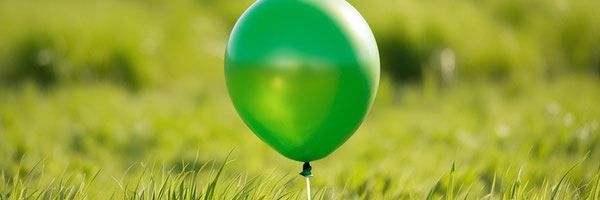What Goes Up Must Come Down
Grade 7
Presentation
No video provided
Problem
The problem is there are many helium balloons released into the biosphere every year. For example, there were 280,000 balloons found on the west coast shore of the U.S in over eight years. Helium balloons can be moved by the wind and end up all over the world.These balloons are landing in the oceans, rivers and on the land hurting millions of animals every year. Research shows that these balloons don't decompose but become microplastics. When the balloons land in farmers fields, cows or other animals will eat them by putting micro plastics into their bodies. If we then eat the animals, we end micro plastics in us. If the balloon lands in the mountain it could end up in our rivers and reservoirs. When we drink the water, we could consume more microplastic. Also, the balloon pieces could land in the oceans and end up eaten by fish which could be eaten by bigger animals. This bioaccumulation could mean animals could end up with millions of micro plastics in them that slowly kill them.
Method
Research
Our research was to determine how far and where helium balloons go if released from Calgary. We searched on the web to determine how long balloons stay in the air before they pop and fall to the ground. Over a week, we determined the daily wind direction, and wind speed in Calgary from the local Environment and Climate change Canada weather station. After we calculated how far and the direction of the balloon travelled based on how many days it would be in the air. After, we plotted where the plastic balloons would end up in the environment across North America. With our map, we determined the different parts of the environment the plastic balloon pieces would negatively impact.
Calculations
To calculate where the balloon would go, we would figure out how long the balloon would stay in the air. For example, a normal sized latex balloon would stay in the air for 10 hours. Then if the average wind speed for the day in Calgary was 15 km per hour, you would times that by how long it stayed in the air. If the wind direction was at 45o we would start at Calgary, and map where the balloon would go depending on the wind speed, wind direction, and how long the balloon stayed in the air. In most cases, the balloon would only travel a day. In some cases, a bigger balloon would stay in the air for 2 to 3 days. If the balloons were to stay in the air more than 1 day, you repeat the calculation each starting at the place the balloon was estimated to travel the day before.
Example of calculation
- hours in the air x wind speed = distance travelled in the direction of the wind for that day
- 10 hrs x 15 km/hr = 150 km, then if the wind direction is 30o the balloon travelled 150 km to the northeast.
In order to plot where the balloon went we had to find how far it travelled on the x axis (west or east) and y axis (south or north). We used the SOH CAH TOA trigonometry method to calculate our x and y numbers. The distance that the balloon travelled (150 km) is the hypotenuse and the x and y distances are the opposite and alternate.
Examples of the calculations and how we plot where the balloon went are shown on this piece of paper.
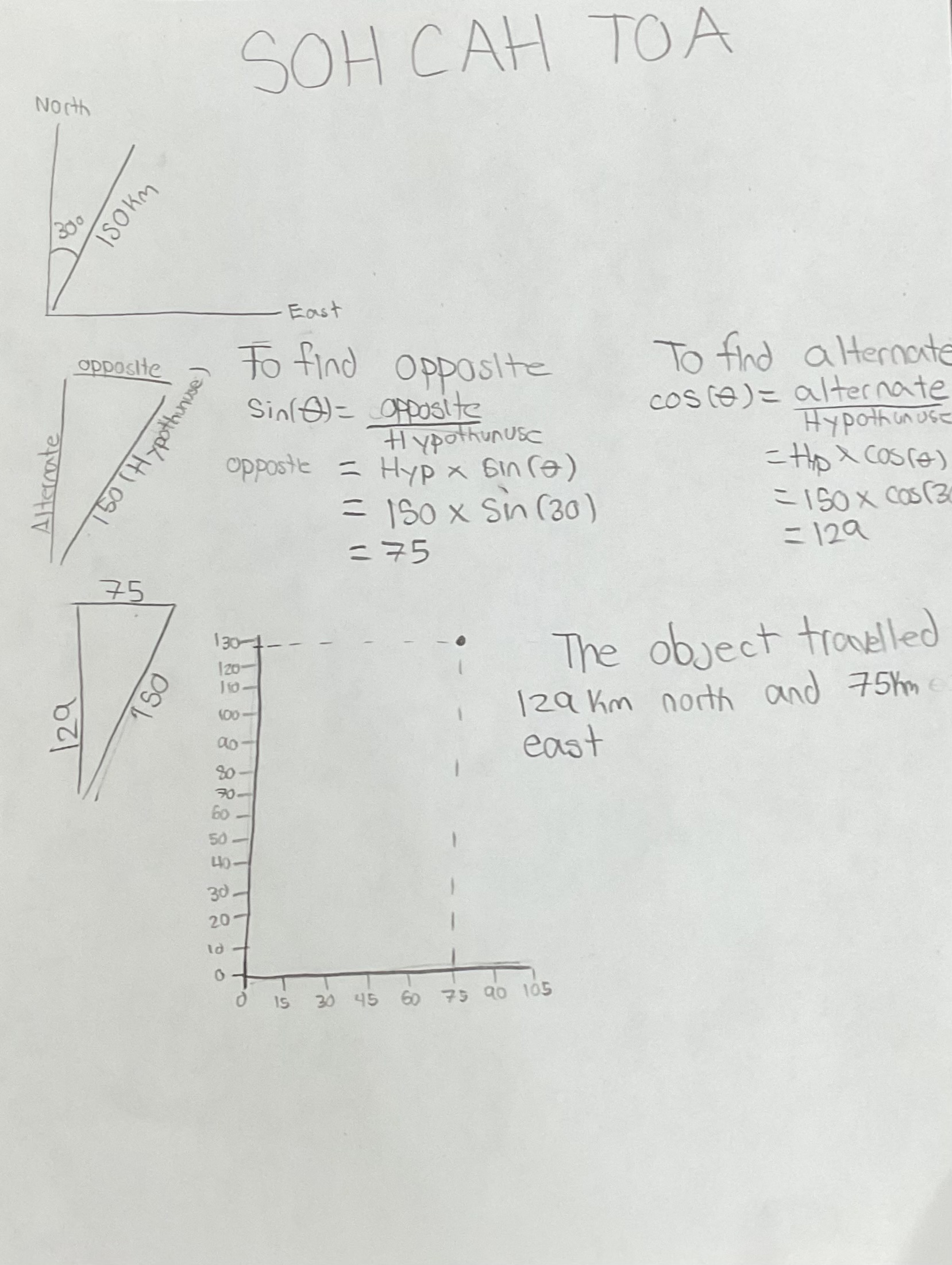
After gathering all the Data we added to an excel spreadsheet so we could easily find all the information (shown in the data section).
The pink dot is the area the balloon might land based on our math. We did this for four different kinds of balloons released on February 27 and plotted them on the map. Then we would think about what would happen in that area the balloons landed. For example some of the dots are near a river so it could land in the river hurting the fish and increasing the micro plastics in the water of the river. Also part of it is over a field area so cows could eat the balloon, then we would eat the cow and have micro plastics in us.
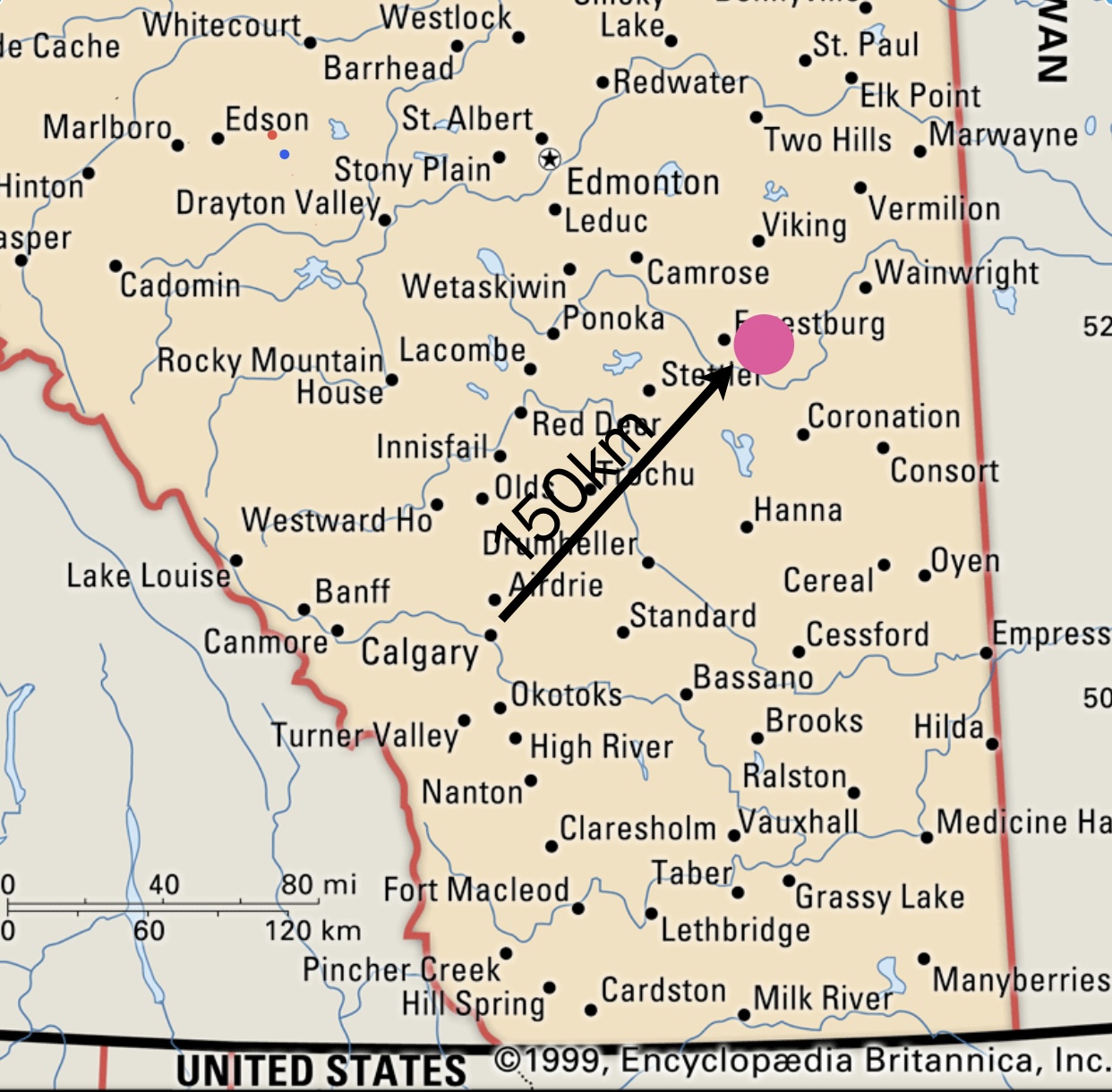
Research
About Our Research
We are researching the impact of released helium balloons on the environment. We researched how long balloons stay in the air. We calculated how far they go when they are released. We researched the impact of released balloons, and what they do to the environment and animals living there, also if the impact will impact us or any of our resources we need to survive.For example drinking water, and animals we eat like cows and fish.
Fun Fact - Did you know that each year around 960 000 balloons are found in Erie lake each year. This means there is 7 680 000 grams of plastic released into the environment. That's a lot!
Balloon Research
Biodegradable balloons
Turns out biodegradable balloons aren't actually very degradable. Even if they don't take as long as normal balloons to disintegrate they can still take up to a year to biodegrade. This means that if an animal eats the pierces it will take at least 6 months before it's gone. According to a link we used, this means that the materials would either suffocate the animal or be stuck in the digestive system of a cow for example, and could starve them to death because they can't digest properly. Also an oak leaf takes just as long, but it doesn't hurt the environment if something eats it. That means that biodegradable balloons arn' t actually safe for animals.
People once did a study where they buried "biodegradable balloons" and after 16 weeks the balloons were not at all degraded. This means that biodegradable balloons aren't actually any better than latex ones. This is alarming because many people buy "biodegradable balloons" and release them thinking they are doing good because they think the balloons are biodegradable.
Balloon Safety
Originally we were going to release a balloon and track it to raise awareness about the effects on the environment. But then we found out about this and decided to change our project to calculations because we didn't want to be unsafe or hurt the environment...
Did you know it's against the law to release balloons in some states in the United States? Some examples of states are Delaware, Maryland, Virginia and Rhode Island. Why? Because of the safety of course. Balloons can cause damage to many things such as power lines if they hit them. This causes important things to get broken. Balloons can also start fires or cause explosions if they hit stuff like that.
Also people found a lot of balloon trash on the beaches on the coast which can pollute the water which people use for drinking and hurt marine animals. People actually counted how much they found while trying to pick up all the trash. They found over a thousand! That's a lot! "So stop releasing balloons!" is what the states said and they passed regulations to make people aware of the problems they are doing to the environment. Hopefully people understood what it did and will stop it.
Why Balloons Pop
There are many ways a balloon can pop. It can get a hole from pokey things, or it can get overpressured. When a balloon is blown up too much there is not enough space and the air/helium pushing on the inside of the balloon makes it pop. Also if the balloon goes too far up in the atmosphere there will be too much pressure pushing on the outside of the balloon making it pop. Lastly, a balloon has miniscule holes from how it's made and when it has been blown up for a long time they get bigger and bigger and eventually it pops.
Why Balloons Go Up
Balloons with air don't go up. Balloons with helium do. Why? First you have to understand that lighter things go up and heavier things go down. This is called buoyancy. Also you have to know that helium is the second element on the periodic table. On the periodic table the number is decided by how many protons are in the element. The less protons the lighter. The more protons the heavier. That means that helium is lighter than air because the air contains many elements which contain more protons meaning it's heavier. So the helium in the balloon floats up while the heavier air goes down.
Also did you know that our helium is running out? Soon it will be gone and we're using it to make balloons float!
Protecting The Planet
Impact they do to the environment
All balloons that are released land eventually somewhere on earth. They could land in a city, field, ocean, or even on top of someone's house. Each balloon is around 8 grams so if 300,000 balloons were found on the west coast of the U.S then that's 2,400,000 grams of plastic found in a small part of the world. It is also very bad for the environment when balloons are made which causes pollution into the atmosphere speeding up climate change and making more extreme weather events happen and the ocean to rise. Did you know about 3 million balloons are made each year and about 1.3 million balloons are released each year?
Other Alternatives to Balloons
There are many celebrations and ceremonies where balloons are released for a congradulations or in memory of someone. Why does it have to be balloons though? Other alternatives would be planting a tree in memory of someone, taking a picture every year for someone's birthday, or another event, tradition, or ceremony. A few other ideas are painting a painting, making something, buying something for yourself, or the celebration, or making a flower bouquet with someone's name on it. If everyone does this and does something that doesn't hurt the environment think about how much better the world could be. It's like if everyone released a balloon, even if it was only one, the world would be covered in balloons.
Regions Where Balloons Land, and How they Impact That Region
If They Land In The Ocean
In the ocean there are many animals such as turtles, fish, etc. Did you know balloons are the 3rd most dangerous ocean trash. Animals can eat them and get microplastics inside them. When one animal eats microplastics and then another animal eats it, it has more microplastics and because as you further up the food chain some of the energy gets lost the animals have to eat more, which means more microplastics. If we keep littering so many balloons then there will eventually be more and more microplastics which can kill animals and won't go away. This is called bioaccumulation and we need to be aware of it.
Also animals can get caught up in the balloons causing them to nor be able to breathe, swim, get away from predators (making the predators lose their instincts), making them unable to find food or injuring them which can cause an infection. Also when animals get balloon pieces stuck to them they can't get it off which can be very dangerous. The more balloons that end up in the ocean or on beaches the more animals get stuck to them or eat them. They think that the plastic/latex is food but it's actually dangerous or toxic to them.
Lastly, if the ocean gets covered in balloons and trash too much it can make garbage islands which are made from currents pulling trash to a specific spot, and littering our beautiful ocean and beaches. This hurts animals, makes ocean activities less fun, and is bad for the planets. Did you know that trash can dirty the water causing unhealthy wildlife, water, and plantlife. We do not want balloons doing this so stop releasing balloons. It can hurt us too. And the planet.
If They Land In a Field
There are also many farms and fields that balloons could end up in. This would hurt the animals that live there. If a cow were to eat a balloon it would most likely die because of suffocation or form the balloon pieces getting stuck in its digestive system making them unable to digest food and would end up starving to death. This is very sad and bad for many reasons. First of all it's a sad story, but also it's sad for the other cows. An example is if a calf dies from a balloon it's very sad for the mother cow and she will not leave the cow. She won't understand that the cow is gone and will try to bring it back to life. She will also not leave the cow for hours. Then there's the farmers. They will have to accept the cows death, bring the cow somewhere because it can't stay there forever and will lose a lot of money and important time. When one cow or other animal dies they will have to spend a lot of time and money to replace it, and raise the other animal, and they will lose a lot of time and money because they won't get the profits from the animal, and any other uses it might be used for. This might even cost up to hundreds or even thousands of dollars.
Also the farmers might be hurt because if too many balloons land in their crops. They will have to pick up the balloons and it also might hurt the crops. According to a farmer that said something in one of the links, they have a couple days where they find no balloons and then the next day they might find 8 or so balloons in their fields. This is also extra sad because if an animal dies from an illness or injury it is unavoidable whereas a balloon is avoidable. Just don't release them.
Finally when cows eat balloons the microplastics will go into their tissue and milk. If they survive the balloon then the microplastics will end up in us if we eat the meat or drink the milk. Did you know that if you get microplastics in your brain they can make you more likely to get dementia sooner. There are also many more medical problems you can get from microplastics being in your body.
If They Land In The Mountains
When balloons land in the mountains they can also hurt many animals. Animals can eat them or get stuck to them. They can also end up in rivers and our reservoirs making more microplastics end up in the water polluting it, hurting animals and ending up in our drinking water. They can also get stuck to cliffs and block vegetation from getting sunlight. Finally, if you want to see the mountains covered in balloons, it would ruin the view.
Someone who collected balloons in Saguaro National Park Arizona said that she estimated she found 16,987 balloons in the 271 square kilometers in the national park! That's approximately 63 balloons per square kilometer!
Research For Calculations
Helium Balloon sizes and time they last in the air
|
Type |
12" latex |
24" latex |
24" confetti latex |
12" confetti latex |
|
Time in the air |
1 day* |
2-3 days* |
2 days |
14 hours * |
|
Amount of plastic |
8 grams |
20-30 grams |
25-30 grams |
12 grams |
Wind speeds and direction in BC and AB (test 1)
|
Date |
Feb 27 (day 1) |
Feb 28 (day 2) |
March 1 (day 3) |
|
|
Speed |
49 km/h |
20km/h |
4km/h |
|
|
Direction |
280o |
11o |
19o |
|
|
Place |
Calgary AB |
Holland Rock BC |
Fort Nelson BC |
Wind speeds for Data ( test 2 )
|
Date |
March 8 (day 1) |
March 9 (day 2) |
March 10 (day 3) |
|
|
Speed |
13km/h |
30km/h |
9km/h |
|
|
Direction |
110o |
130o |
210o |
|
|
Place |
Calgary AB |
Holland Rock BC |
Fort Nelson BC |
Data
We collected data on where the four balloons would go if we released them on February 27 2025. We calculated and mapped out where the balloons would go and what would happen in the region they landed in. From the wind speeds we found on the weather stats canada we use it to find how far the balloons would go and where. We charted the data using the app Excel.
This is our excel sheet that we use to gather our data.
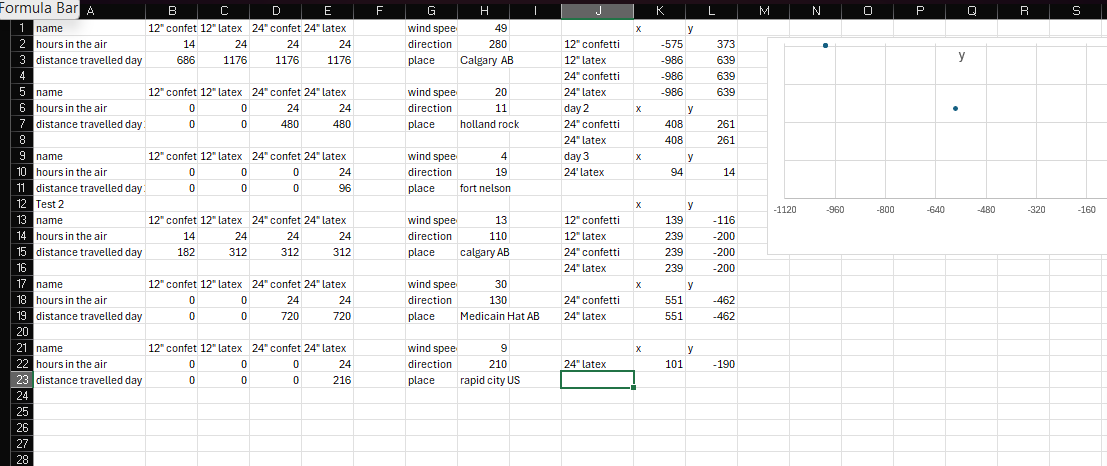
Balloon Release 1
Day 1 (Starting in Calgary AB)
On day one the four types of balloons are theoretically released and all are in the air but the 12" latex confetti lands after 14 hours.
|
type
|
12" latex
|
12" latex confetti
|
24" latex
|
24" latex confetti
|
|
distance traveled (km)
|
1176
|
686
|
1176
|
1176
|
|
time in air (hours)
|
24
|
14
|
24
|
24
|
|
wind speed 49 km/h
|
|
|
|
|
The 12" latex confetti floats in the sky 575 km west and 373 km north landing 686 km away from calgary. The 12" latex, 24" latex, and the 24" latex confetti float after 24 hours 986 km west and 639 km north ending 1176 km away from Calgary.
Day 2 ( Starting Near Holland Rock BC)
After day one both 12" balloons have stopped floating.
|
type
|
12" latex
|
12" latex confetti
|
24" latex
|
24" latex confetti
|
|
distance traveled (km)
|
-
|
-
|
480
|
480
|
|
time in air (hours)
|
-
|
-
|
24
|
24
|
|
wind speed 20km/h
|
|
|
|
|
24" latex, and the 24" latex confetti float after 24 hours 408 km north and 261 km east ending 480 km away from Holland Rock BC.
Day 3 ( Starting Near Fort Nelson BC)
After day 2 the 24" confetti stopped floating. After day 3 all the balloons have stopped floating and landed around canada.
|
type
|
12" latex
|
12" latex confetti
|
24" latex
|
24" latex confetti
|
|
distance traveled (km)
|
-
|
-
|
-
|
96
|
|
time in air (hours)
|
-
|
-
|
-
|
24
|
|
wind speed 4km/h
|
|
|
|
|
24" latex after 24 hours in the air floats 94 km north and 14 km east ending 480 km away from Fort Nelson BC.
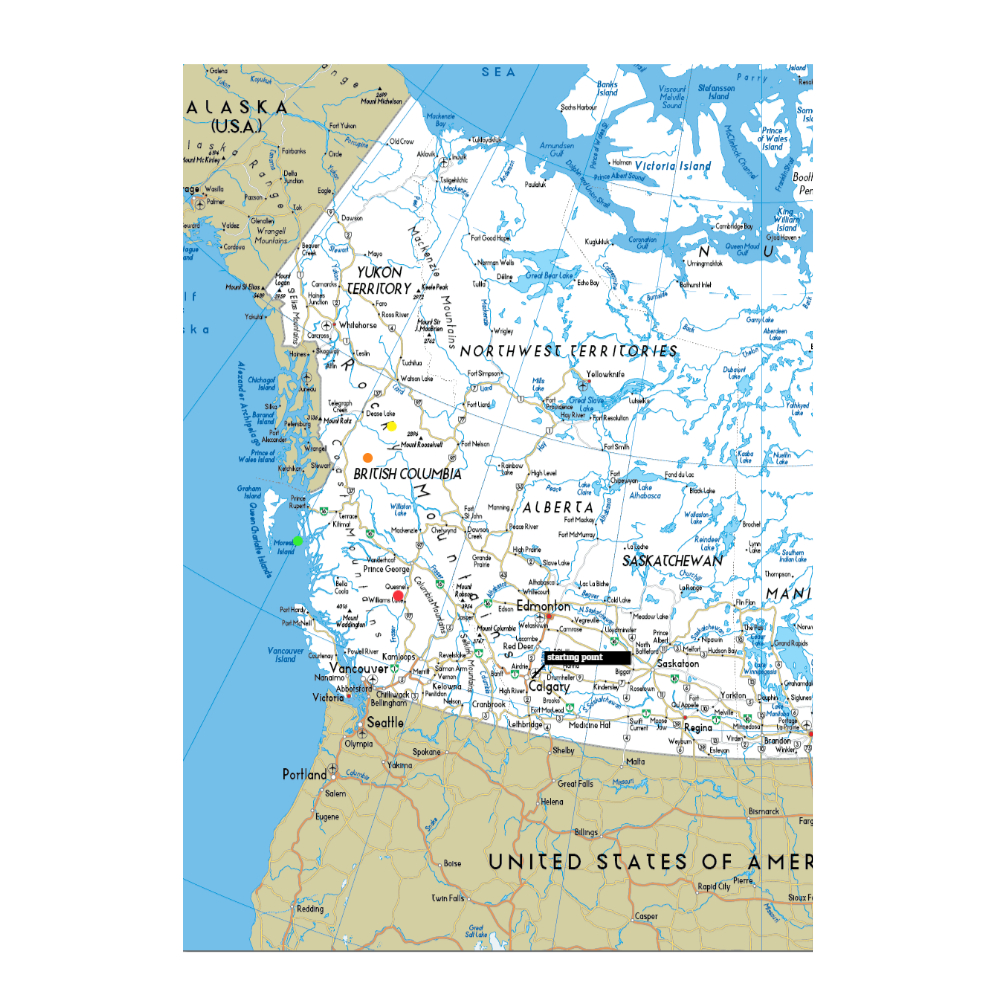
Balloon A (red dot)
Balloon A is the 12" confetti balloon that stayed in the air for 14 hours. It landed a little west of the Columbia Mountains. In this region it could land in the mountains or in any nearby cities. If it were to land in the mountains it could easily end up in a river leading to a reservoir. If you lived in a city by the columbian mountains I could even land in your backyard.
Balloon B (neon green dot)
Balloon B is the most common balloon, the 12" latex. It was able to last in the air for 24 hours. This balloon was the only one to land in the ocean, meaning it could harm many animals there and end up on our beaches. Also when landing in an ocean the current could take the balloon across the world ending up in different places so us releasing balloons will affect the environment and others.
Balloon C (orange dot)
balloon C is the 24" latex confetti. It floated in the air for 48 hours, and landed in between Fort Nelson and Prince Rupart. where it landed there are lots of forests and ecosystems that interact there. When a balloon lands there it can cause many animals to be affected even if only one animal eats it.
Balloon D ( yellow dot)
Balloon D is the 24" latex, and It lasts 2-3 days in the air. it landed a little west of mount roosevelt. In this area there are lots of trees, plants, and beautiful mountain ranges. Also there are many ecosystems, and animals that can be affected by the plastic.
Balloon Release 2
Day 1 (Starting in Calgary AB)
|
type
|
12" latex
|
12" latex confetti
|
24" latex
|
24" latex confetti
|
|
distance traveled (km)
|
182 |
312 |
312 |
312 |
|
time in air (hours)
|
14 |
24 |
24 |
24 |
|
wind speed 13 km/h
|
|
|
|
|
Balloon A went 139 km east and 116 km south. Balloons B, C, and D went west 239 km and south 200km. Balloons A, and B landed.
Day 2 ( Landed in Medicine Hat AB)
|
type
|
12" latex
|
12" latex confetti
|
24" latex
|
24" latex confetti
|
|
distance traveled (km)
|
-
|
-
|
720 |
720 |
|
time in air (hours)
|
-
|
-
|
24 |
24 |
|
wind speed 30km/h
|
|
|
|
|
Balloons C, and D went west 551 km and south 462 km. Balloon C landed.
Day 3 (Landed in Rapid City US)
|
type
|
12" latex
|
12" latex confetti
|
24" latex
|
24" latex confetti
|
|
distance traveled (km)
|
-
|
-
|
-
|
216 |
|
time in air (hours)
|
-
|
-
|
-
|
24 |
|
wind speed 9 km/h
|
|
|
|
|
Ballons D went west 101km and south 190km. Balloon D landed.
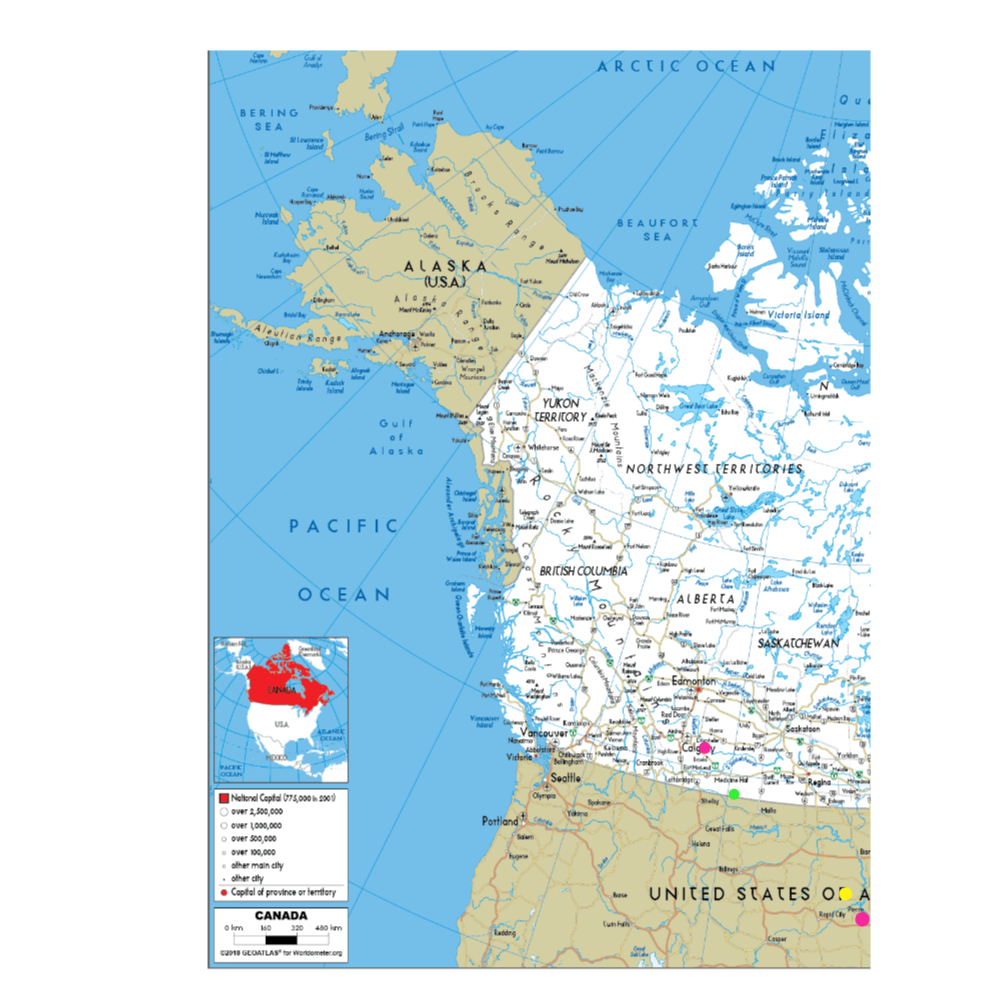
Balloon A ( pink dot)
Balloon A stayed in the air for 14 hours and landed just outside of calgary. It landed in an area with lots of farm lands and fields. When landing in a field it could get eaten by a farm animal or pollute the plant growing there.
Balloon B ( green dot)
Balloon B landed a little south of Medicine Hat where it could easily land on a house, office building, basically anywhere in the city. When it lands in a city it could land on a power line causing power outages in small parts of the city. Also it could land in the city's water reservoir if they have one.
Balloon C ( yellow dot)
Balloon C landed in the US near Rapid city. It's Not good since it means that when releasing balloons it affects other places around the world and when the release balloons can affect us by landing in alberta.
Balloon D ( red dot)
Balloon D is also very close to Balloon C. Again it has the same problems as Balloon C: affecting other places. THis means that when we pollute the earth it can pollute other places too.
Conclusion
Conclusion for Calculations (Round 1)
We learned through the calculations a lot of things. But just so you know this is only for if they were released from Calgary on February 27th 2025 because the wind directions, and wind speeds change constantly. First is the order of when the balloons land. The 12" latex confetti lands first after 14 hours. Then the 12" latex would land after 24 hours. The 24" latex takes 72 hours and the 24" latex confetti lands after 48 hours. That means that the 12" latex confetti and 12" latex are done after day one, the 24" latex confetti is done after day 2 and the 24" latex takes 3 days to land.
Then we learned how far each balloon would go. On day one the 12" latex confetti would go 575 km west and 373 km north landing 686 km away from Calgary. The 12" latex, 24" latex, and the 24" latex confetti go 986 km west and 639 km north ending up 1176 km away from Calgary. After day two the 24" latex, and the 24" latex confetti go 408 km north and 261 km east ending 480 km away from Holland Rock BC. Lastly on day three the 24" latex goes 94 km north and 14 km east ending 480 km away from Fort Nelson BC. The main thing we learned from the research is that the balloons can go a long way hurting the environment in many places.
Conclusion for Calculations (Round 2)
We learned through the calculations a lot of things. This is only for if they were released from Calgary on March 8th 2025 because the wind directions, and wind speeds change constantly. First is the order of when the balloons land.
Then we learned how far each balloon would go. On day one the 12" latex confetti would go 139 km east and 116km south landing 182 km away from Calgary. The 12" latex, 24" latex, and the 24" latex confetti go 239 km east and 200 km south ending up 312 km away from Calgary. After day two the 24" latex, and the 24" latex confetti go 462 km south and 551 km east ending 720 km away from Medicine Hat. Lastly on day three the 24" latex goes 190 km south and 101 km east ending 216 km away from Rapid City. The main thing we learned from the research is that the balloons can go a long way hurting the environment in many places.
Conclusion for Research
We also learned from our research that biodegradable balloons aren't actually what they appear to be and can still be very dangerous, that it is very unsafe to release balloons both for the environment and human made things and humans, and that there are many alternatives to releasing balloons that don't have as much of a negative impact. We also learned that balloons pop from pressure or sharpness on either the inside or outside of the balloon, and that helium balloons float because helium is lighter than the air in the Earth's atmosphere and lighter things float while heavier things sink.
Next we learned that balloons contain microplastics that can hurt the ecosystem and living things, that those can get passed down the food chain causing bioaccumulation and that the pieces can get into water or the tissue of cows for example and get to us which can hurt us too. We learned that this is a big problem for farmers and animals that live on farms, animals and other living things in the ocean, animals living in the forests or mountains, as well as any other habitat where living creatures make their homes, and if they end up where humans live it can also have a negative impact on us.
Final Summary
All in all we learned that releasing balloons is not good for animals, humans or our planet and it can go way beyond our neighborhood, hurting oceans, farms, forests or mountains too. And lastly, different balloon types and different days can change where a balloon goes, where it ends up, and how long it stays in the air. We also learned a lot about the SOH CAH DAO method and other things while doing the calculations.
Citations
https://www.fws.gov/story/2015-08/balloons-and-wildlife-please-dont-release-your-balloons (Balloon release research)
https://calgary.weatherstats.ca/charts/wind_speed-hourly.html (Wind speed and direction information in Calgary)
March 10 Weather in Rapid City: Detailed Weather Forecast for March 10 in Rapid City, South Dakota, United States ( wind speed for the US)
https://www.oceanconservation.org/research/balloon-pollution/ (Balloon release research in the ocean and the impact that they do)
https://www.dolphinsafari.com/how-balloons-in-the-ocean-kill-marine-life/(How many balloons are released)
https://gaia.vcu.edu/portal/apps/storymaps/stories/83154e32217a4c15b4c29aaa2c82c966 (Balloons in the ocean)
https://www.thedodo.com/in-the-wild/balloons-hurt-animals-risks (Balloons hurt animals)
https://www.britannica.com/place/Alberta-province (Map of Alberta)
https://greencitizen.com/blog/biodegradable-balloons/ (Biodegradable balloons are not very biodegradable)
https://www.cbsnews.com/minnesota/news/balloons-environmental-impact/ (Laws to stop balloon releasing)
https://www.forbes.com/sites/marshallshepherd/2019/05/28/why-the-balloon-release-tradition-is-terrible-for-the-environment/ (Why balloons are bad for the enviroment)
chrome-extension://efaidnbmnnnibpcajpcglclefindmkaj/https://media.iadsnetwork.com/edition/2021/1981/207741/0b4ce80c-4c33-419e-87d4-e62a39a3a8a7.pdf (Farmers don't like balloon releases)
https://www.bobochachaballoon.com/why-do-balloons-pop-the-science-behind-the-sudden-burst/ (Why balloons pop)
https://sciencemom.teachable.com/p/chemistry (Why balloons float) I took the chemistry course a few years ago)
https://www.nps.gov/sagu/learn/nature/airborne-trash.htm (Balloons in the mountains)
( For our header and prodject image we use Canva dream lab to creat an AI image)
Excel
Acknowledgement
We would like to acknowledge these people...
- The teacher (Naomi Cohen) who gave us her classroom to work in during lunch times, introduced us to the information we needed to do for the science fair, and ordered the triflods
- Lauren's mom for helping us learn how to do the calculations and how map it all out
Also for our header and project image we used AI to make a green balloon in a field.

